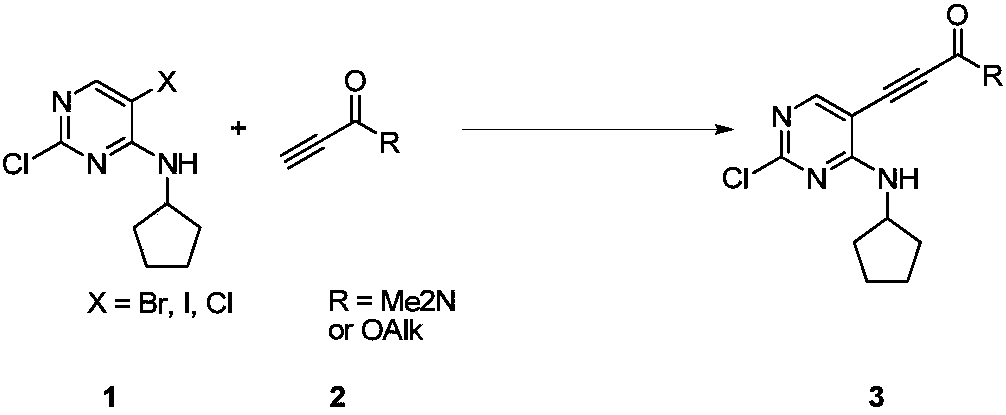The synthetic method of ribociclib intermediate
A technology of ribociclib and a synthesis method, which is applied in the new synthesis field of intermediate compounds, can solve the problems of inconvenient process amplification, high risk of worker operation, unfavorable process amplification, etc., and achieves optimization of coupling conditions and shortening of reaction steps. , the effect of simple operation
- Summary
- Abstract
- Description
- Claims
- Application Information
AI Technical Summary
Problems solved by technology
Method used
Image
Examples
Embodiment 1
[0033]
[0034] Add 5-bromo-2-chloro-4-(cyclopentylamino)pyrimidine 1a (27.66g, 100mmol) in the three-necked flask, ethyl propiolate 2a (19.62g, 200mmol), DABCO (2.24g, 20mmol) and Acetonitrile (277mL), stirred evenly, cooled to 0-5°C, switched nitrogen three times under vacuum, added newly prepared cuprous iodide (1.9g, 10mmol) and dichloroditriphenylphosphine palladium (702mg, 1mmol) under nitrogen protection After the addition, the temperature was raised to 55-60°C for 6-8 hours. After the reaction, most of the acetonitrile was rotated off, and 277 mL of water was added to quench the reaction. The aqueous phase was extracted 3 times with ethyl acetate (138 mL), and the combined organic phase was washed with saturated brine for 1 (138 mL), dried over sodium sulfate, concentrated and separated by column chromatography with a mixed solvent of dichloromethane and methanol to obtain compound 3a (21.44 g, 73%). ESIm / z=294.10(M+1), 1 HNMR(CDCl3,400MHz)δ8.25(s,1H),4.28(q,J=7.2H...
Embodiment 2
[0037]
[0038] Add 5-iodo-2-chloro-4-(cyclopentylamino) pyrimidine 1b (32.36g, 100mmol) in the three-necked flask, ethyl propiolate 2b (19.62g, 200mmol), DABCO (2.24g, 20mmol) and Acetonitrile (324mL), stirred evenly and cooled to 0-5°C, switched nitrogen three times under vacuum, added newly prepared cuprous iodide (1.9g, 10mmol) and dichloroditriphenylphosphine palladium (702mg, 1mmol) under nitrogen protection After the addition, the temperature was raised to 55-60°C for 6-8 hours. After the reaction, most of the acetonitrile was spun off, and 324 mL of water was added to quench the reaction. The aqueous phase was extracted 3 times with ethyl acetate (162 mL), and the combined organic phase was washed with saturated brine for 2 (162 mL), dried over sodium sulfate, concentrated and separated by column chromatography with a mixed solvent of dichloromethane and methanol to obtain compound 3b (23.71 g, 81%). ESIm / z=293.11(M+1), 1HNMR(CDCl3,400MHz)δ8.27(s,1H),3.82-3.70(m,1H...
Embodiment 3
[0041]
[0042] Add 3a (29.37g, 100mmol) and dimethylformamide (147mL) into the three-necked flask, stir evenly, switch nitrogen in vacuum for 3 times, and add new cuprous chloride (0.99g, 10mmol) and DBU (3.04g , 20mmol), after the addition was completed, the temperature was raised to 85-90°C to react overnight. At the end of the reaction, 294 mL of water was added to quench the reaction, the aqueous phase was extracted 3 times with ethyl acetate (147 mL), the combined organic phase was washed 2 times with saturated brine (147 mL), dried over sodium sulfate, concentrated and separated by column chromatography with dichloromethane methanol mixed solvent Compound 4a (25.26 g, 86%) was obtained.
[0043] Cuprous chloride in embodiment 3 can be replaced by cuprous bromide, and 1,8-diazabicyclo[5.4.0]undec-7-ene (DBU) can be used diisopropylethylamine, triethylamine amine or triethylenediamine (DABCO) instead; the solvent dimethylformamide can be replaced by dimethylacetamide,...
PUM
 Login to View More
Login to View More Abstract
Description
Claims
Application Information
 Login to View More
Login to View More - R&D
- Intellectual Property
- Life Sciences
- Materials
- Tech Scout
- Unparalleled Data Quality
- Higher Quality Content
- 60% Fewer Hallucinations
Browse by: Latest US Patents, China's latest patents, Technical Efficacy Thesaurus, Application Domain, Technology Topic, Popular Technical Reports.
© 2025 PatSnap. All rights reserved.Legal|Privacy policy|Modern Slavery Act Transparency Statement|Sitemap|About US| Contact US: help@patsnap.com



